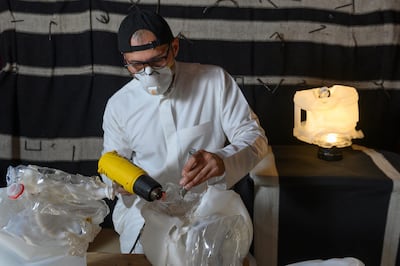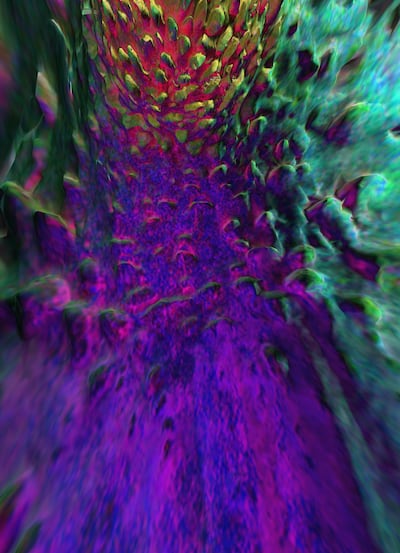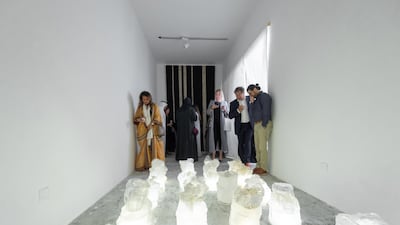Exhibition design is an overlooked art – and the discipline's grandiose buzzwords, such as "4D spatial storytelling," tend to backfire, eliciting eye-rolls rather than focusing attention on the skill itself. But there is a moment in I Love You, Urgently, the main show at Jeddah's 21, 39 art week, curated by Maya El Khalil, when exhibition design comes into its own, and the show's blueprint forces a beautiful interlude between the examinations of present and future in the Gulf.
The source of the interlude is camel shanties. When camel herding was a more common practice across the Arabian Gulf, herders used to sing songs to their animals to calm them. Saudi Arabian artist Sultan bin Fahad – whose Red Palace exhibition is now at the Cultural Foundation in Abu Dhabi – has created the work Al Hidaa' (2019) celebrating these songs, which are played in his installation made up of deformed plastic bottles – as if detritus from the desert – and goat-hair blankets.
The room is bracketed off by curtains, creating a corridor in the main section of the exhibition, held in the Saudi Art Council spaces in the Gold Moor Mall. Its sounds echo across the galleries, evoking, in part, the contemporary sound of khaleeji chanting – which will be familiar to anyone in the Gulf who has attended a festival or event opening.

I Love You, Urgently looks to natural forms, communities, connections, and a level-playing field between humans and the natural world – ideas such as camel herders singing lullabies to their animals. Its ostensible focus is the continuing climate emergency, though the artists involved in the exhibition were inspired not just by climate change, but by the strategies and shifts in mind-sets that will be necessary to improve or adapt to a changed planet.
"I asked artists to think about three core ideas," El Khalil says. "The first was biomimicry – a connection with nature, learning from nature, from 3.8 billion years of evolution. The second was adaptability: decisions might need to be amended very quickly, and the needs themselves might need to be amended very quickly. And the third was specificity: to look at our environment and to think, what are the specific needs?" Each of the works on show were commissioned, and the 21, 39 organisers worked with the artists from research phase to final result.
El Khalil opens I Love You, Urgently, with an archival display of the work of German architect Frei Otto, who was inspired by natural forms in the environment. Otto designed numerous buildings in Saudi Arabia, of which the best known is the Tuwaiq Palace leisure centre in Riyadh, with its multicoloured, stained-glass-like tent that soars over the Diplomatic Club. The tents throughout the building draw on the properties of natural load-bearing systems such as webs and soap bubbles to allow for their lightweight adaptability – crucial in the hot environment of the Gulf.
A number of artists responded to the brief for the seventh 21, 39 by foregrounding connectivity. Saudi Arabian artist Daniah Al Saleh's digital installation Delicate (2019) demonstrates the idea of emergent strategy, where systems are built non-hierarchically, starting from the individual upwards. Alaa Tarabzouni and Fahad bin Naif explore the Yamamah Saudi Cement Company in Al Manakh area outside of Riyadh, which has supplied the building material for most of the capital (Al Manakh, You Will Be Missed, 2019). Established in the 1960s, it has grown to such a large site that it has developed its own internal culture, with generations living and working there. The artists lay out items found around the site as if in an archaeological analysis of the culture that has developed there – not simply impugning the site for its environmental transformation, but also offering it as a new ecosystem on its own terms.
Like Tarabzouni and bin Naif, others address environmental concerns specific to the region: namely oil extraction and rapid urbanisation. Ayman Zedani creates a futuristic video that imagines the life-cycle of oil across its eons of formation. Mohammed Kazem contributes oblique references to the human cost of the Gulf's transformation. The Emirati artist shows exquisite paintings of half-finished construction sites in Dubai, titled Sound of Light (2019). What's missing in these is the labourers, as the paintings gently comment on the invisibility of this group of people.

Most of the artists are from Saudi Arabia or the Gulf, and many show some of their best work here. At Think Store 2520, the exhibition's site in Al Balad, Raja'a Khalid has created Tesla desert drift (2020), three inky black, iridescent bulbous forms that mimic the fragrance diffuser – the ubiquitous domestic item they are modelled on. The three olfactory sculptures evoke the smell of a Tesla in the middle of a desert: drawing on notes of sand (surprisingly peppery), asphalt, and Tesla's vegan interior. Whereas sometimes Khalid's art can overly rely on her act of appropriation, her work here offers something newly formed, a complex distillation on luxuries in the Gulf and the contradictions that bankroll it.
Saudi artist Filwa Nazer, who started out as a fashion designer, has made an artwork out of stiff white fabric based on insects in Saudi Arabia, such as the wonderfully named blue-shinned grasshopper and the Oleander hawk-moth. These have developed camouflage to such an extent that they become invisible – a practice that has been related to forms of psychosis, where people lose their sense of self amid efforts to conform. In Nazer's reformulation, In the Fold (2019), the visitor can step into the costume, enveloping him or herself in its ethereal white folds. Sadly, though, due to the fragility of the fabric, the exhibition organisers could not allow the piece to be activated in this way.
There are some places where the idea of natural forms feel literal, or disconnected to the underlying ideas of engagement between the human and plant or animal worlds. Zahrah Al Ghamdi's installation Ashgan Village (2020), drawn from acacia trees, feels too visually close to her work with leather, which is similarly spread out across gallery walls, as in her Venice Biennale presentation. And the bleakness of Maha Nasrallah's water vessel forms (Thawra, 2018-2019), though powerful objects in their own right, seem at odds with the exhibition's note of stoicism.
The show – rather remarkably – manages to frame the climate crisis as an opportunity for change for the better. "If we respect the environment, then we respect each other as human beings, because we're part of the environment," says an impassioned El Khalil. "Respect across classes, across economic situations, across political affiliations, across species. Respect is so important. This should define the future."
I Love You, Urgently is on display at the Saudi Art Council spaces in the Gold Moor Mall, and Think Store 2520, in Al Balad, as part of 21,39 in Jeddah. Both shows run until Saturday, April 18


